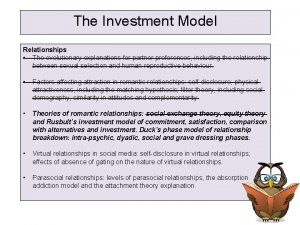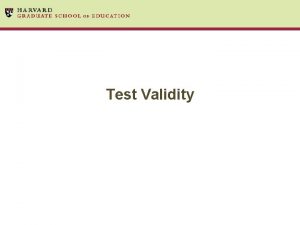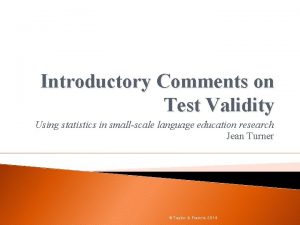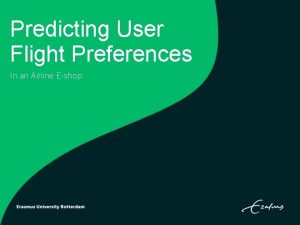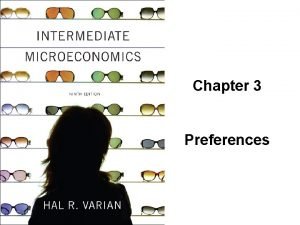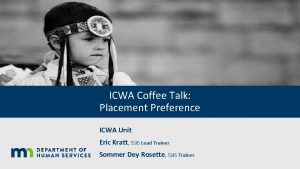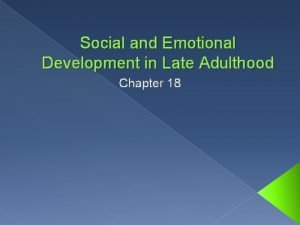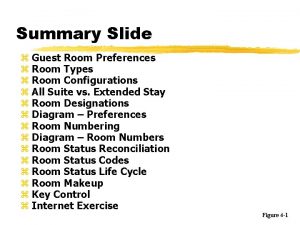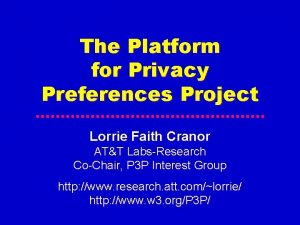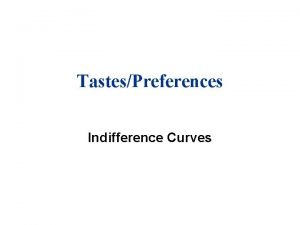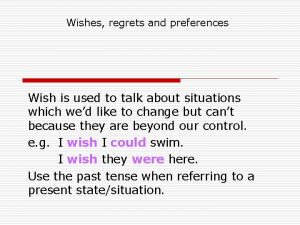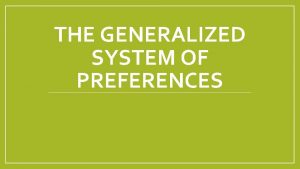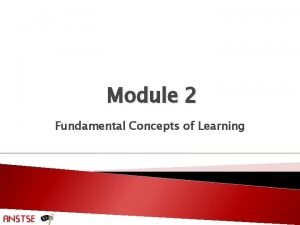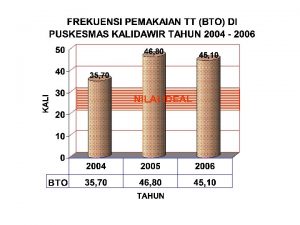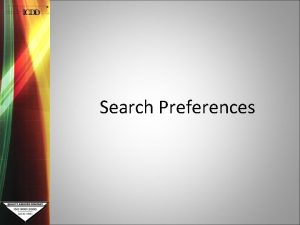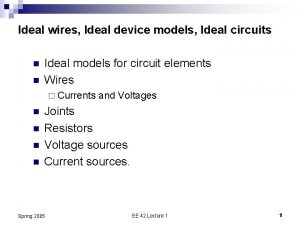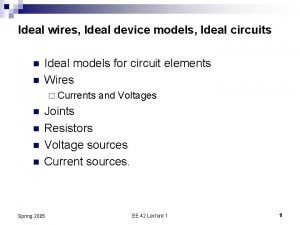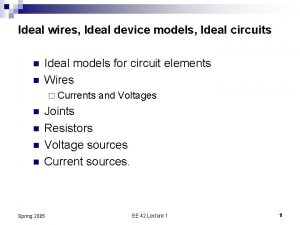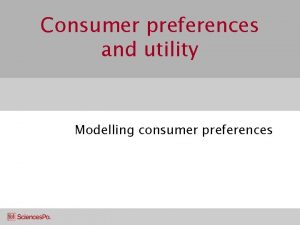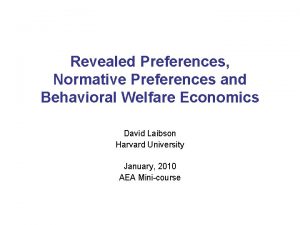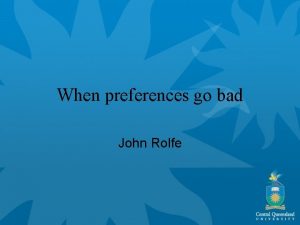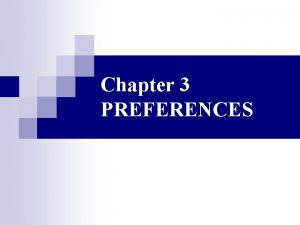The Predictive Validity of Ideal Partner Preferences in



























- Slides: 27

The Predictive Validity of Ideal Partner Preferences in Relationship Formation Lorne Campbell The University of Western Ontario In collaboration with Sarah C. E. Stanton

Research on Partner Preferences • Vast—over 48 k Google Scholar hits to various keywords associated with interpersonal attraction • Largely self-report – Provide people a list of qualities to rate on importance – Ask people to list qualities they are looking for in a partner



Sprecher, Sullivan and Hatfield, 1994 Goal of Study Table of Means • Asked a nationally representative sample of men and women in the USA how willing they would be to marry someone possessing a number of different traits Variable Men Women Not “good looking” 3. 41 4. 42 Younger by 5 years 4. 54 2. 80 Not likely to hold a steady job 2. 73 1. 62 Earn less than you 4. 60 3. 76 Earn more than you 5. 19 5. 93

Important Assumption • What people say they want in a future partner should be associated with the actual characteristics of their future partners – i. e. , partner preferences somehow implicated in actual mate search/mate choice

Research Support: “Yes” • Buriss et al (2011) – When women prefer more masculine men as partners, they are with more masculine-looking men • Kenrick & Keefe (1992) – Age preferences for long-term partners – Age of actual marriages in diverse samples

Research Support: “Yes” • Elder (1969); Taylor & Glenn (1976) – More physically attractive women marry men with higher occupational status • Perusse (1993; 1994) – Large samples of men and women report on recent sexual behavior • Men: social status linked to sexual opportunities • Women: age linked to sexual opportunities

Research Support: “No” • Eastwick & Finkel (2008) – Speed-dating study: 4 -minute “dates” – Provide preferences before “dates”; rate appeal of each “date”; answer questions 10 different times over a 30 day period following event – Match between self-evaluations of “dates” and one’s own stated preferences did not predict romantic attraction – Conclusion: people lack introspective awareness of what influence their mate choices

Research Support: “No” • Eastwick et al. (2011) – Match between preferences and profile of opposite-sex other predicted attraction – After interaction with this person (confederate), that association went away – Conclusion: properties of the interactions are particularly important for attraction

Footnote • But see Li et al. , (2013) and Fletcher, Kerr, Li, & Valentine, (2014) for data suggesting that individuals’ preferences do predict actual choices using similar “get acquainted” paradigms

Meta-Analysis • Eastwick et al. (2014) • Conclusions: – (1) individuals are more satisfied with current romantic partners who more closely match their ideal preferences – (2) single individuals are more attracted to hypothetical partners who more closely match their preferences

Meta-Analysis • Eastwick et al. (2014) • Conclusions: – (3) preferences of single individuals, however, do not appear to predict how attracted those individuals were to actual potential partners following live interactions with them • “…just because participants claim to value particular qualities in a mate does not mean that they will preferentially pursue partners who possess such qualities” (p. 647).

Participant Status 6 5 1% 2% 4 3 2% 1% 7 12% 1 30% 2 52% 1 = single only; 2 = involved only; 3 = recruited when single and asked about prior dating experiences; 4 = recruited when single and asked over time about actual dating experiences; 5 = recruited when single and followed until involved in a committed relationship; 6 = recruited when involved in a committed relationship and asked about how the relationship began/developed; 7 = both single and involved people in a committed relationship recruited. * From: Campbell & Stanton (2014), DOI: 10. 1111/spc 3. 12126

Research Focus 3 3% 1 37% 2 60% 1 = interpersonal attraction/liking 2 = later relationship processes 3 = formation/initiation of new relationships. * From: Campbell & Stanton (2014), DOI: 10. 1111/spc 3. 12126

Little Research Focuses on Relationship Formation • Three studies in the meta-analysis focused on relationship formation to some degree: – (1) Eastwick et al. (2008) – (2) Asendorpf et al. (2011) – the probabilities for various kinds of contact in their sample was “… 6. 6% for a developing romantic relationship 6 weeks after speed-dating, 5. 8% for sexual intercourse at any time in the year following speed-dating, and 4. 4% for reports of romantic relationships 1 year after speed-dating. ” – (3) Sprecher & Duck (1994) • Very few, if any, matched couples had a second date

Eastwick et al. (2014) • “If theoretical account of a particular finding contains the assumption (explicit or implicit) that the stated preference for a specific attribute translates into a revealed preference for that same attribute, theoretical account could be in need of revision. ” (Eastwick et al. , 2014, p. 648; italics added)

This Conclusion Gaining Traction • Gildersleeve et al. (2014), in meta-analysis on the ovulatory shift hypothesis: • “…given that several studies have found that stated preferences are only weakly predictive of real-life dating behavior (see, e. g. , Eastwick & Finkel, 2008; Eastwick, Luchies, Finkel, & Hunt, 2013; Todd, Penke, Fasolo, & Lenton, 2007), it remains an open question whether women have explicit knowledge of and can accurately report on the mate preferences that influence their real-life attractions” (p. 32) • Joel et al. (2014) – First line of abstract: “Mate preferences often fail to correspond with actual mate choices. ”

Too Early to Make Definitive Conclusions • No systematic empirical literature on predictive validity of ideal partner preferences in relationship formation • Cannot make conclusions in the absence of data • But, studying actual relationship formation is hard

Our First Empirical Effort • Assumption: preferences when single should be positively associated with the self-reported qualities of new romantic partners • Study design: obtain preferences from a lot of single people, follow them over time, try to recruit new partner when relationship forms • First original research I pre-registered: https: //osf. io/9 gf 4 q/

Participants • Started with 450 single people, excluded 24, left with 426 – Over 5 months, 167 entered new relationships • 85 provided us contact information of new partner – 45 accepted the invitation » 38 new partners completed the survey

Materials • Ideal partner preferences and self-perceptions were assessed across 38 qualities (e. g. , “understanding, ” “good lover, ” “ambitious, ”) used extensively in prior research • Murray et al’s 20 -item Interpersonal Qualities Scale (IQS) • Fletcher et al’s 18 -item Ideal Standards Scale (ISS) • All study materials etc can be found here: https: //osf. io/me 7 jp/

Primary Analyses • Multilevel Modeling – Preferences and self-evaluations nested within dyad • Allows for assessing within-dyad associations (averaged across dyads)

Models • Model 1: • DV = new partners’ self-evaluations across 38 traits • IV = original participants’ partner preferences assessed when single • Model 2: • DV = original participants’ self-evaluations across 38 traits assessed when single • IV = new partners’ partner preferences

Table of Results Table 2 Multilevel Models Testing the Effects of Original Participants’ Ideal Preferences Predicting New Partners’ Self-Perceptions (Model 1) and New Partners’ Ideal Preferences Predicting Original Participants’ Self-Perceptions (Model 2) Model 1 Model 2 Analysis b SE t 95% CI r Original Analysis . 36 . 07 5. 29*** . 22, . 49 . 14 . 33 . 06 5. 91*** . 22, . 44 . 16 Self-Evaluations Included . 27 . 06 4. 56*** . 15, . 38 . 12 . 25 . 05 4. 90*** . 15, . 35 . 13 No Dating History Only . 42 . 08 5. 58*** . 27, . 57 . 17 . 37 . 07 5. 68*** . 24, . 50 . 17 Stereotype Accuracy . 30 . 06 5. 21*** . 19, . 41 . 14 . 26 . 05 4. 97*** . 16, . 37 . 13 Note. Unstandardized regression coefficients are reported. Approximate effect sizes were computed using the formula r = √(t 2/(t 2 + df)) (see Rosenthal & Rosnow, 2007). Degrees of freedom ranged between 1333 -1395 for models estimated with all couples, and were 1101 for the models with couples with no dating history. ***p <. 001

Thoughts • What the data imply: – In our sample, participants entered relationships with others that had qualities (self-reported) positively corresponding their preferences when single • What the data do not imply: – How this happened

What is Needed • (1) Replication with larger sample • (2) Larger sample would also allow for tests of between-dyad associations • E. g. , predicting relationship quality, stability • (3) Exactly how might preferences influence mate choice? • New research approaches needed – Go beyond attraction in the lab – But manage to assess variability in potential partner options as well as actual mate choices given these options
 Criterion related validity definition
Criterion related validity definition Investment model relationships
Investment model relationships Concurrent validity
Concurrent validity Validity
Validity Criterion validity definition
Criterion validity definition Type of claims and examples
Type of claims and examples Flight preferences
Flight preferences Career choices and preferences in hrm
Career choices and preferences in hrm Well-behaved preferences
Well-behaved preferences Icwa placement preferences
Icwa placement preferences Peck's theory of ego integrity
Peck's theory of ego integrity Guest room preferences
Guest room preferences Tisc preferences
Tisc preferences Vtac preferences
Vtac preferences Platform for privacy preferences project
Platform for privacy preferences project Rfc4191
Rfc4191 Weakly preferred vs strictly preferred
Weakly preferred vs strictly preferred About wishes and preferences topic
About wishes and preferences topic How do you save panel locations and visibility preferences?
How do you save panel locations and visibility preferences? Gsp wto
Gsp wto Learning style
Learning style Mendeley desktop preferences
Mendeley desktop preferences Immiscible
Immiscible Bổ thể
Bổ thể Tư thế ngồi viết
Tư thế ngồi viết Thẻ vin
Thẻ vin Thể thơ truyền thống
Thể thơ truyền thống Các châu lục và đại dương trên thế giới
Các châu lục và đại dương trên thế giới

